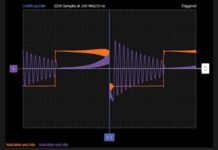Abstract
A new control loop architecture is designed to generate very low noise voltages. This can be utilized by both linear and switching regulators. In addition to the low noise achieved, the level of noise becomes independent of the set output voltage. This also makes it possible to generate very low output voltages down to 0 V.
Power converters typically incorporate a control loop to maintain a set output voltage, irrespective of variations in input voltage or load current.
A resistor divider is often used to sense output voltage. One is depicted in Figure 1, which illustrates a step-down converting buck regulator circuit. In this control loop, a resistor divider (RFB1 and RFB2) adjusts the generated output voltage to a level specified by the internal reference voltage (VREF). This reference voltage is commonly set at 1.2 V, 0.8 V, or 0.6 V. The error amplifier’s output (operational amplifier in Figure 1) is then fed into a control block that manages the switching times of the power switches (MOSFETs).

For a long time, this type of traditional regulation method was standard. However, a superior alternative now exists that offers many advantages for power conversion, including switching regulators and low dropout (LDO) regulators. Figure 2 shows the new concept, which employs a unity-gain architecture where the output voltage is fed directly to the error amplifier. The output voltage is adjusted with a resistor (RSET) connected to an internal power source. This configuration allows the output voltage to be adjusted down to 0 V, unlike the previous method using a resistor divider shown in Figure 1, where the minimum adjustable output voltage is equal to the potential of the internally installed reference voltage.
Another advantage is the ability to produce less noise at low frequencies below 100 kHz. By incorporating a CSET capacitance, it averages the low frequency disturbances from the internal current source, substantially reducing these interferences.
In this new architecture, the resistors of the resistor divider do not introduce additional noise, making the noise behavior largely independent of the output voltage. Consequently, the low frequency noise does not increase with higher output voltages.
Many of Analog Devices’ ultralow noise linear regulators, such as the LT3045 20 V, 500 mA ultralow noise LDO regulator, use this loop regulation technology. New step-down switching regulators from the third-generation Silent Switcher family, such as the LTC8625S, are designed using this innovative approach.
Click here to read the full article.

















